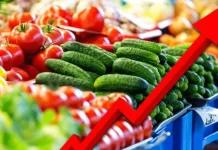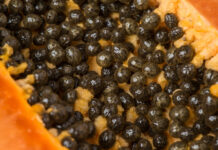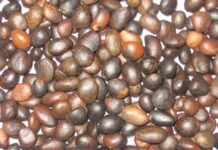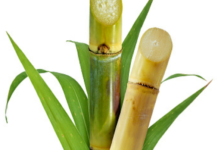In all likelihood, the first thing you do when you eat an orange is tear off that thick peel and throw it straight into the garbage. Guess what? You’re missing out on a lot of nutrients. The peel of an orange has nearly twice as much vitamin C as the flesh inside. And though it may seem gross at first, there are plenty of tasty ways you can eat orange peels if you’re willing to get a little creative.
The same is true of lots of fruits and veggies; the peel is often the most nutritious part, and can be eaten despite what you think. Bananas? Yep. Watermelon? Sounds unbelievable, but it’s true: that rind is great for you. Here are some fruits and vegetables with powerful peels you should be eating, along with suggestions for how to add them to your diet. You might remove the skin of a fruit or a vegetable out of habit, but there are many of them that can be eaten without peeling, as the skins are packed with vitamins and minerals.
 Potatoes
Potatoes
Potato skins are full of iron and potassium. In fact, 70% of the iron in a potato is in the skin alone. A potato’s skin packs more nutrients—iron, calcium, potassium, magnesium, vitamin B6 and vitamin C—ounce-for-ounce than the rest of the potato. Ditch the skin and you’ll also lose up to 90 percent of a potato’s iron content and half of its fibre. And don’t forget the skin of a sweet potato is loaded with a significant amount of beta-carotene, which converts to vitamin A during digestion. Vitamin A is essential for cell health and immune system regulation, and it is extremely useful in maintaining organ function.
Peach
Peach skin is high in vitamins E and K, potassium, magnesium, phosphorus, manganese, zinc and copper.
Guava
Guava can help with high blood pressure. It’s also used in diarrhoea and constipation treatment.
 Cucumber
Cucumber
Cucumber peel helps in reducing constipation and can protect from colon cancer. The dark green skin contains the majority of a cucumber’s antioxidants, insoluble fibre and potassium. The cucumber peel also holds most of its vitamin K.
Apple
If you remove the skin of the apple, you lose an antioxidant called quercetin which can help the lungs to function well, ease breathing problems and also it is believed to fight off brain tissue damage and protect the memory. The skin of an apple contains about half of the apple’s overall dietary fibre content. By removing the peel, you lose about a third of those nutrients. The peel also has four times more vitamin K than its flesh; about 5 percent of your daily value. An apple’s skin boasts potential benefits beyond its vitamin content.
 Pear
Pear
Pears are high in vitamin C, a cancer-busting vitamin, and pectin which lower cholesterol. As with carrots, much of the goodness is just below the skin.
Carrots
Many people are in the habit of peeling the skin of the carrot because they feel that it is too dirty, not knowing that they are wasting some goodness away. Carrots are rich in carotene – which is good for eyes and skin – and fibre. Since the skin of a carrot is the same colour as what’s directly beneath it (like a tomato or a red pepper), the peel and its flesh have similar nutritional properties. However, the highest concentration of phytonutrients is found in a carrot’s skin or immediately underneath. Just rinse the carrot thoroughly rather than peeling it.
Beets
Beetroot can be boiled or roasted with the skin on. It is rich in folate which can prevent anaemia. It also contains antioxidants which can aid anti-ageing.
 Banana
Banana
The peel of a banana has a high serotonin content (a mood-balancing chemical) which can help reduce depression. It also has an antioxidant lutein which is good for eyesight. A banana’s peel contains way more fibre than its flesh, and is likewise richer in potassium. But the peel has a bitter taste and tough, many people aren’t used to eating it. An overripe banana (brown or black) becomes thinner, sweeter and easier to chew. You can also put the peel (ripe or overripe) through a juicer with the rest of the banana. Or you can boil the peel for several minutes to make it softer. If you want to get really creative, bake a banana peel in the oven for 20 minutes or so, or until it becomes dried out, then use it to make tea.
 Watermelon
Watermelon
Although watermelon flesh is good for health, the rind is equally beneficial, being high in vitamin C, B6 and citrulline, an amino acid which is used to lower blood pressure. All watermelon contains citrulline, which has antioxidant properties and converts to arginine, an essential amino acid that is beneficial to the heart, immune system and circulatory system.
Mandarin Orange
Citrus fruits with peel contain more vitamin C than it’s inside part, and is high in antioxidants. The peel of an orange packs in twice as much vitamin C as what’s inside. It also contains higher concentrations of riboflavin, vitamin B6, calcium, magnesium and potassium. The peel’s flavonoids have anti-cancer and anti-inflammatory properties. As nutritious as citrus peels are, the entire peel is bitter and difficult to digest. Instead, grate the peel and sprinkle it on top of salads or you can boil the peel in water and take as tea.
Kiwi
Kiwi peel contains anti-cancer, anti-inflammatory and anti-allergenic properties which help in overall body development. You have probably been eating just the green flesh inside for years, but a kiwi’s peel is also edible. In fact, the skin contains more flavonoids, antioxidants and vitamin C than the insides—and double the fibre. So ditch just eating the flesh, wash the kiwi and eat it like a peach. If you find the fuzz unappetizing, scrape it off first.












